![]() ARMOR protects your body if you are hit and mitigates potential damage, preventing it from reducing your health. It is important to realize that armor does not prevent you from being hit. In fact, the opposite is true: too much armor can be cumbersome and make you more likely to get hit. That’s not to say that having armor isn’t good. It is. It could potentially save your skin in a battle. But like many things, there’s a tradeoff.
ARMOR protects your body if you are hit and mitigates potential damage, preventing it from reducing your health. It is important to realize that armor does not prevent you from being hit. In fact, the opposite is true: too much armor can be cumbersome and make you more likely to get hit. That’s not to say that having armor isn’t good. It is. It could potentially save your skin in a battle. But like many things, there’s a tradeoff.
Typically you will purchase armor from the Merchant in town, although there is also a traveling merchant that shows up each Fall during the Harvest Festival who carries rare and exotic gear (which is also typically very expensive). But you will want to check the merchandise on offer at the Merchant on a regular basis as the stock rotates often.
When you initially start a new game, you’ll basically have a shirt, cheap pants and cheap shoes. These do offer slight protection, but not much. Don’t expect to be able to afford armor right off the bat. You will likely spend all of your money getting the best weapon you can afford. But as you progress, you’ll want to pick up pieces of armor to protect yourself.
It may seem like a good idea to load up on as much ARMOR as possible, but there are serious drawbacks to having too much armor. Many armors such as PLATE, SCALE, CHAIN, and BANDED, are very heavy metals and will both lower your accuracy and take up valuable carrying weight that could be used to bring back loot. More than one novice has spent their hard-earned money on a shiny metal breastplate, only to find out that they can barely stand after equipping it!
HARDENED armors don’t weigh as much as metals, but still weigh a good amount. LEATHER is lighter than that, and CLOTH and PADDED armors are much lighter, but of course protect less.
There are five spots on your body for which you can equip armor: HEAD, TORSO, PANTS, GLOVES and BOOTS. You can only wear one piece of armor in each spot. Generally when hit during a melee or ranged attack, one part of the body is hit and takes all the damage (usually selected randomly but the chance is prorated by relative size). Some abilities will hit multiple body parts and spread the damage around. But when a part is hit, only the armor protecting that part mitigates damage. That means that if you have a big steel breastplate protecting your TORSO, but nothing on your HEAD, if you’re hit in the head your other armor does nothing for you. For this reason, it is generally better to have multiple lesser armor pieces covering each body part than just a few stronger pieces, even if they’re just CLOTH.
When selecting armors, it is important to not just consider the ![]() ARMOR value, but also the
ARMOR value, but also the ![]() WEIGHT and the
WEIGHT and the ![]() ACC PENALTY. Several factors play into these values, as described here.
ACC PENALTY. Several factors play into these values, as described here.
Similar to weapons, armors are made from various MATERIALS. Metal armors (PLATE, SCALE, CHAIN and BANDED) can be made from (in order from worse to better) IRON, BRONZE, STEEL and LAVA-FORGED. HARDENED armors are made from BONE. LEATHER armor can be made from GOAT HIDE, COW HIDE, OX HIDE, MINOTAUR HIDE, LIZARDMAN HIDE, and DRAGON HIDE. CLOTH and PADDED armors can be COURSE, PLAIN, GILDED, and VELVETEEN. Heavier armors will incur a larger ACC PENALTY. LEATHER, PADDED and CLOTH armors are usually light enough they don’t incur an ACC PENALTY.
Also similar to weapons, armors have a QUALITY rating that ranks (from worse to better) POOR, INFERIOR, AVERAGE, FINE, SUPERIOR, and EXQUISITE. Like weapons, when the quality qualifier is missing from the name, it is assumed to be AVERAGE.
Armor also has a RARITY value, similar to weapons. An armor’s RARITY will not affect any stats except for price. However, “better” armors will tend to be more rare, so there is a loose correlation. Rarity can be described as COMMON, RARE, VERY RARE, EXTREMELY RARE, and UNIQUE. For items beyond COMMON, the background color of the armor’s thumbnail will change. RARE and VERY RARE are light blue, EXTREMELY RARE is pink, and UNIQUE is gold.
Some armors can have magikal effects, such as resistances to negative effects (e.g., ![]() BLIND,
BLIND, ![]() BLEED,
BLEED, ![]() PANIC, etc), resistance to elemental damage (
PANIC, etc), resistance to elemental damage (![]() FIRE,
FIRE, ![]() ICE,
ICE, ![]() SHOCK, or
SHOCK, or ![]() POISON), grant higher accuracy and damage for a given weapon type, increase movement, give off light, give bonuses for inflicting status effects, plus more. Generally, the magikal effects correspond to an appropriate part of the body. For example, you’re not likely to get an accuracy bonus from a chest piece but can from either a helmet or gloves. Similarly, boosting your movement is likely to be attached to a set of boots, not gloves. Magikal armors have their descriptions listed in dark blue. These armors can come in all qualities, materials and rarities, but being magikal will typically raise the price several fold if not more.
POISON), grant higher accuracy and damage for a given weapon type, increase movement, give off light, give bonuses for inflicting status effects, plus more. Generally, the magikal effects correspond to an appropriate part of the body. For example, you’re not likely to get an accuracy bonus from a chest piece but can from either a helmet or gloves. Similarly, boosting your movement is likely to be attached to a set of boots, not gloves. Magikal armors have their descriptions listed in dark blue. These armors can come in all qualities, materials and rarities, but being magikal will typically raise the price several fold if not more.
Some armors can have elemental resistances that are not magikal in nature. For example, gloves may be fur-lined and provide limited ![]() ICE RESISTANCE. These are more expensive than their comparable non-protected peers, but not by as much as truly magikal gear.
ICE RESISTANCE. These are more expensive than their comparable non-protected peers, but not by as much as truly magikal gear.
As armor is hit and mitigates damage, its ![]() CONDITION will deteriorate. The more damage that it sustains, the less it will mitigate. Some attacks, like
CONDITION will deteriorate. The more damage that it sustains, the less it will mitigate. Some attacks, like ![]() ACID, are particularly damaging to armors. Each armor piece will display a quick-reference green, yellow or red dot over its thumbnail, but the anvil icon will show its condition as a percentage. Once its condition reaches zero, it will no longer mitigate any more damage. Damaged armor needs to be repaired back in town at the Blacksmith, and it will cost you more depending on how badly damaged it is and the underlying value of the armor itself. More expensive armor is more expensive to repair.
ACID, are particularly damaging to armors. Each armor piece will display a quick-reference green, yellow or red dot over its thumbnail, but the anvil icon will show its condition as a percentage. Once its condition reaches zero, it will no longer mitigate any more damage. Damaged armor needs to be repaired back in town at the Blacksmith, and it will cost you more depending on how badly damaged it is and the underlying value of the armor itself. More expensive armor is more expensive to repair.
One last thing to note about armor that is very important. Armor will mitigate PHYSICAL damage only. It will not prevent negative status effects, like ![]() BLIND,
BLIND, ![]() BLEED,
BLEED, ![]() WEAK, etc., unless it is magikal and has some sort of resistance attached. It also will not block any ELEMENTAL damage (
WEAK, etc., unless it is magikal and has some sort of resistance attached. It also will not block any ELEMENTAL damage (![]() FIRE,
FIRE, ![]() ICE,
ICE, ![]() SHOCK or
SHOCK or ![]() POISON). That is very important to remember, and also puts a weapon like a WAND in a new light. Many monsters have considerable armor. Even though many abilities or weapons like a WAND only do a small amount of elemental damage, they essentially bypass any armor. That can be a very important thing to keep in mind during a battle with a tank.
POISON). That is very important to remember, and also puts a weapon like a WAND in a new light. Many monsters have considerable armor. Even though many abilities or weapons like a WAND only do a small amount of elemental damage, they essentially bypass any armor. That can be a very important thing to keep in mind during a battle with a tank.
 SHIELDS can be wielded in your left hand when you have equipped a one-handed weapon in your right hand. You cannot use a shield if you have a two-handed weapon equipped. The one-handed weapon can be either a melee (like a dagger or one-handed axe) or ranged weapon (such as a wand). Any class can wield a shield, but there are skills that characters and NPC’s can slot to improve stats for wielding them.
SHIELDS can be wielded in your left hand when you have equipped a one-handed weapon in your right hand. You cannot use a shield if you have a two-handed weapon equipped. The one-handed weapon can be either a melee (like a dagger or one-handed axe) or ranged weapon (such as a wand). Any class can wield a shield, but there are skills that characters and NPC’s can slot to improve stats for wielding them.
Shields come in varying sizes, with BUCKLERS being the smallest, followed by SMALL, MEDIUM, ASPIS, LARGE, and finally TOWER (just slightly less than the height of an average person). Shields are also typically classified as either WOODEN or METAL. Wooden shields can be (in ranking of quality) OAK, HICKORY, MAHOGANY, ROSEWOOD, or IRONWOOD. Metal shields can be (in order) IRON, BRONZE, STEEL or LAVA-FORGED. Similar to weapons and armor, shields are also categorized by quality spanning POOR, INFERIOR, AVERAGE, SUPERIOR, FINE and EXQUISITE. Generally, metal and larger shields have higher stats, but weigh more. A higher quality will boost stats (but doesn’t affect weight), and larger shields have higher accuracy penalties (see below).
Shields contribute to ![]() DEF via BLOCKING (indicated by the
DEF via BLOCKING (indicated by the ![]() icon). Weapons can do this too (look for the
icon). Weapons can do this too (look for the ![]() icon), but shields tend to contribute significantly more depending on their size, material and quality. As described in the Accuracy, Defense and Magik Defense section of the Guide, when wielding both a shield and a one-handed weapon, whichever BLOCKING value is higher will be used. Weapon and shield BLOCKING values do not stack … it is one or the other.
icon), but shields tend to contribute significantly more depending on their size, material and quality. As described in the Accuracy, Defense and Magik Defense section of the Guide, when wielding both a shield and a one-handed weapon, whichever BLOCKING value is higher will be used. Weapon and shield BLOCKING values do not stack … it is one or the other.
The drawback to wielding a shield is each has an ![]() ACCURACY PENALTY. This is because shields are cumbersome. Only the size of the shield (not material or quality) determines this, and the larger the shield, the more the penalty. However, slotting the Shield Handling skill will reduce this penalty. This penalty can be significant (but so can the DEF bonus from BLOCKING). So shields are really a tradeoff between ACC and DEF. But better materials and quality, as well as the right skills, can skew this tradeoff so the DEF bonuses outweigh the ACC penalties.
ACCURACY PENALTY. This is because shields are cumbersome. Only the size of the shield (not material or quality) determines this, and the larger the shield, the more the penalty. However, slotting the Shield Handling skill will reduce this penalty. This penalty can be significant (but so can the DEF bonus from BLOCKING). So shields are really a tradeoff between ACC and DEF. But better materials and quality, as well as the right skills, can skew this tradeoff so the DEF bonuses outweigh the ACC penalties.
NOTE: Similar to weapons and armor, shields can also be magikal and possess special traits, such as providing light or protection from ELEMENTAL damage (![]() FIRE,
FIRE, ![]() ICE,
ICE, ![]() SHOCK or
SHOCK or ![]() POISON).
POISON).
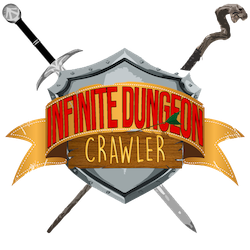
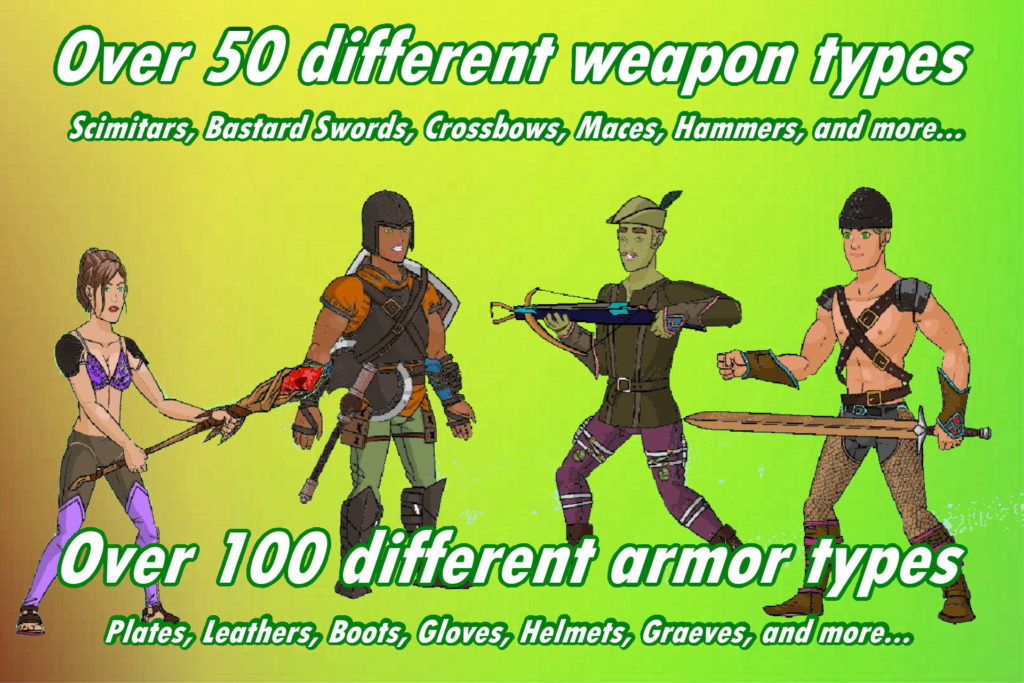 IDC has a wide variety of weapons to choose from. Most of these are purchased at the Merchant in town, and the selection available is frequently changing. Having a good weapon is critical to the game. But money is usually tight. In the game you will spend most of your money earned from expeditions in pursuit of better and better equipment. You’ll pretty much want to check the Merchant’s stock at least every other time you come back from an expedition. But also keep in mind that if you have your eye on a particular piece of gear, it may not be there by the time you save up. Evervale is a busy place and the Merchant’s stock is constantly rotating. Generally, if you see something you like and you have the funds, grab it.
IDC has a wide variety of weapons to choose from. Most of these are purchased at the Merchant in town, and the selection available is frequently changing. Having a good weapon is critical to the game. But money is usually tight. In the game you will spend most of your money earned from expeditions in pursuit of better and better equipment. You’ll pretty much want to check the Merchant’s stock at least every other time you come back from an expedition. But also keep in mind that if you have your eye on a particular piece of gear, it may not be there by the time you save up. Evervale is a busy place and the Merchant’s stock is constantly rotating. Generally, if you see something you like and you have the funds, grab it. 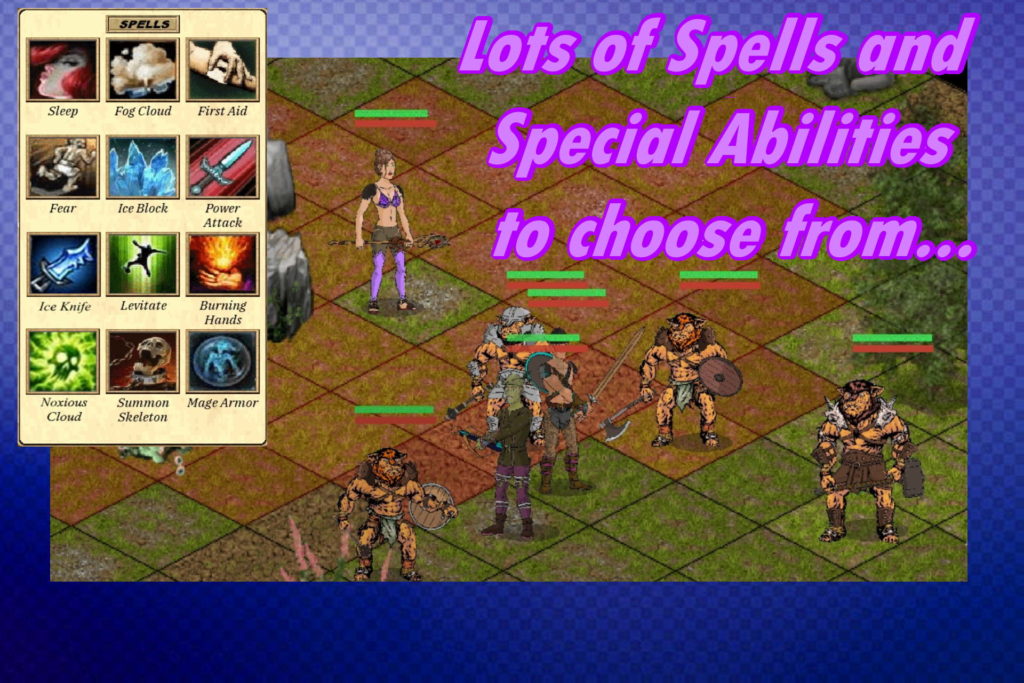
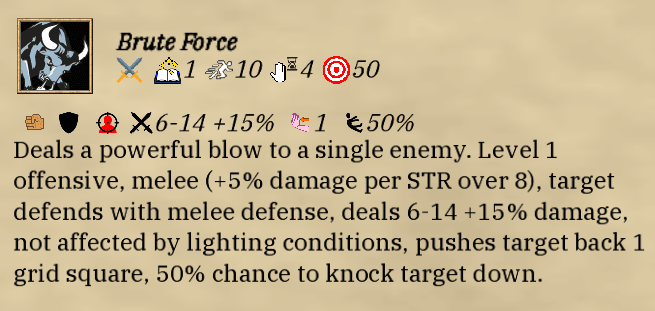 A good example is the Fighter’s Brute Force ability, as shown above. This ability lets the user ram into an adjacent opponent causing damage and potentially knocking them down. The ability itself has an underlying ACC of 50 for this specific character, as shown by
A good example is the Fighter’s Brute Force ability, as shown above. This ability lets the user ram into an adjacent opponent causing damage and potentially knocking them down. The ability itself has an underlying ACC of 50 for this specific character, as shown by  Some abilities only cause status effects and do no physical damage. These abilities typically only have one roll for the effect itself — not a roll to determine an initial “hit” or “miss”. A good example of this is the Rogue’s Cheap Shot ability, as seen in this figure, which throws sand in the face of his or her victim potentially causing
Some abilities only cause status effects and do no physical damage. These abilities typically only have one roll for the effect itself — not a roll to determine an initial “hit” or “miss”. A good example of this is the Rogue’s Cheap Shot ability, as seen in this figure, which throws sand in the face of his or her victim potentially causing 
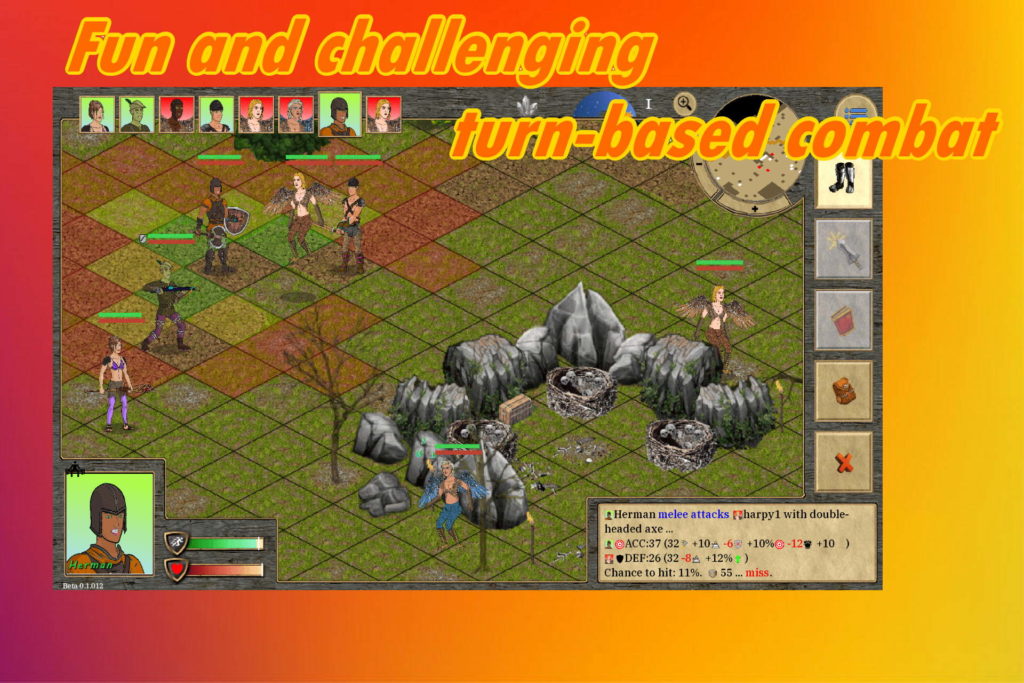 One of the things you will notice right away with IDC is that it is fairly difficult to land a hit, even at higher levels and especially at lower levels. Most monsters are pretty good at defending themselves (luckily so are most adventurers!) Paying attention to the stats as presented in the COMBAT LOG, especially ACCURACY (ACC) and DEFENSE (DEF), are key to successfully battling monsters.
One of the things you will notice right away with IDC is that it is fairly difficult to land a hit, even at higher levels and especially at lower levels. Most monsters are pretty good at defending themselves (luckily so are most adventurers!) Paying attention to the stats as presented in the COMBAT LOG, especially ACCURACY (ACC) and DEFENSE (DEF), are key to successfully battling monsters.


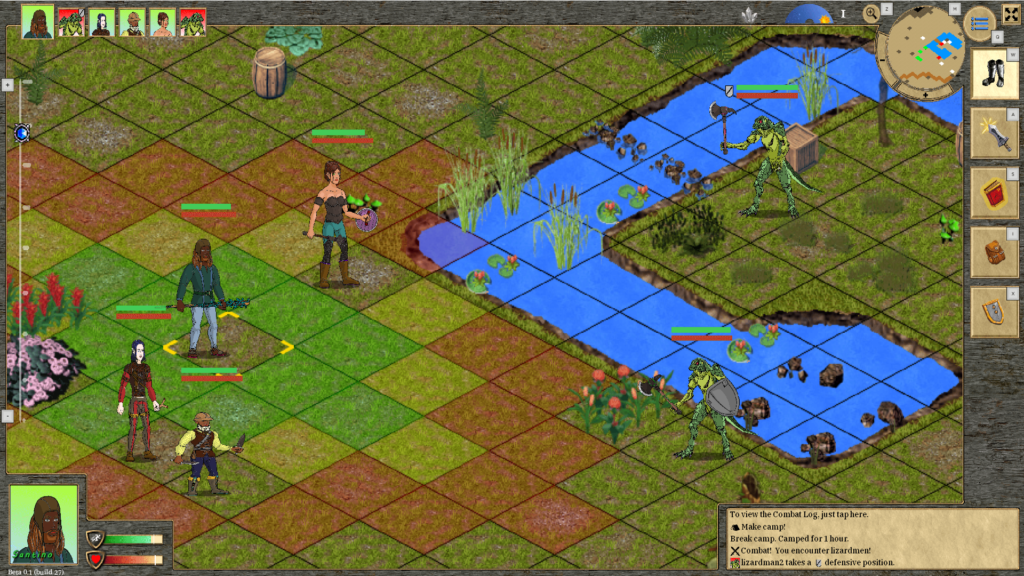
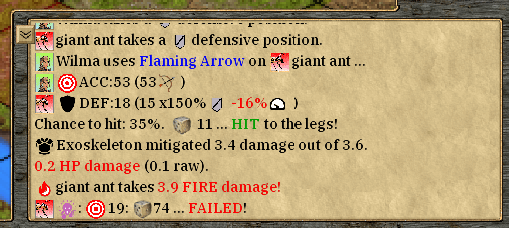 A portion of any physical damage taken will reduce your maximum health. For normal attacks from melee or ranged weapons, this can vary from between 20-50% on any given hit. For example, in the figure to the right you can see in this COMBAT LOG that the character took 0.2 HP of damage. They also sustained 0.1 of that as “raw” damage, which was 50% of the base damage (the part in parenthesis, deducted from maximum health).
A portion of any physical damage taken will reduce your maximum health. For normal attacks from melee or ranged weapons, this can vary from between 20-50% on any given hit. For example, in the figure to the right you can see in this COMBAT LOG that the character took 0.2 HP of damage. They also sustained 0.1 of that as “raw” damage, which was 50% of the base damage (the part in parenthesis, deducted from maximum health).